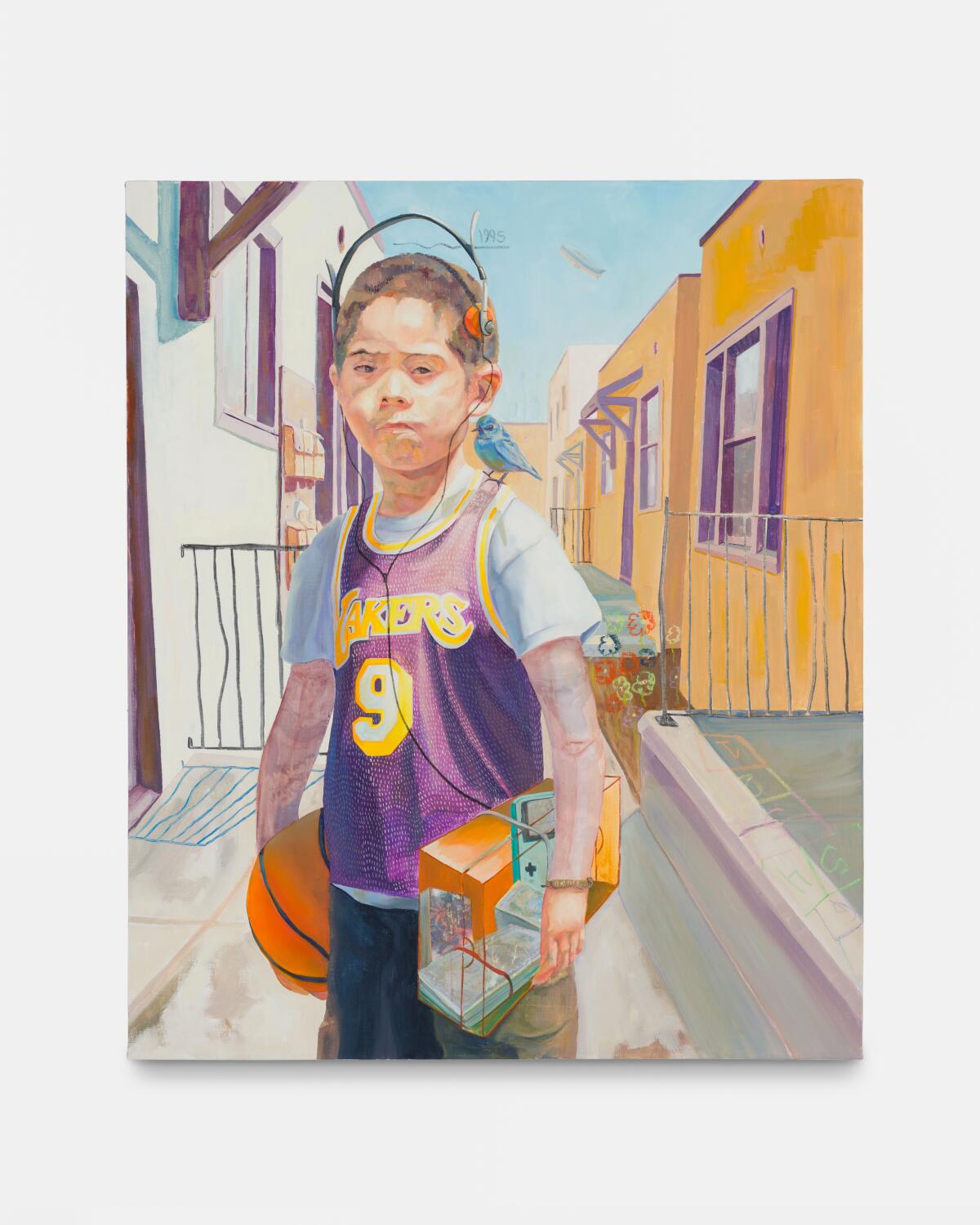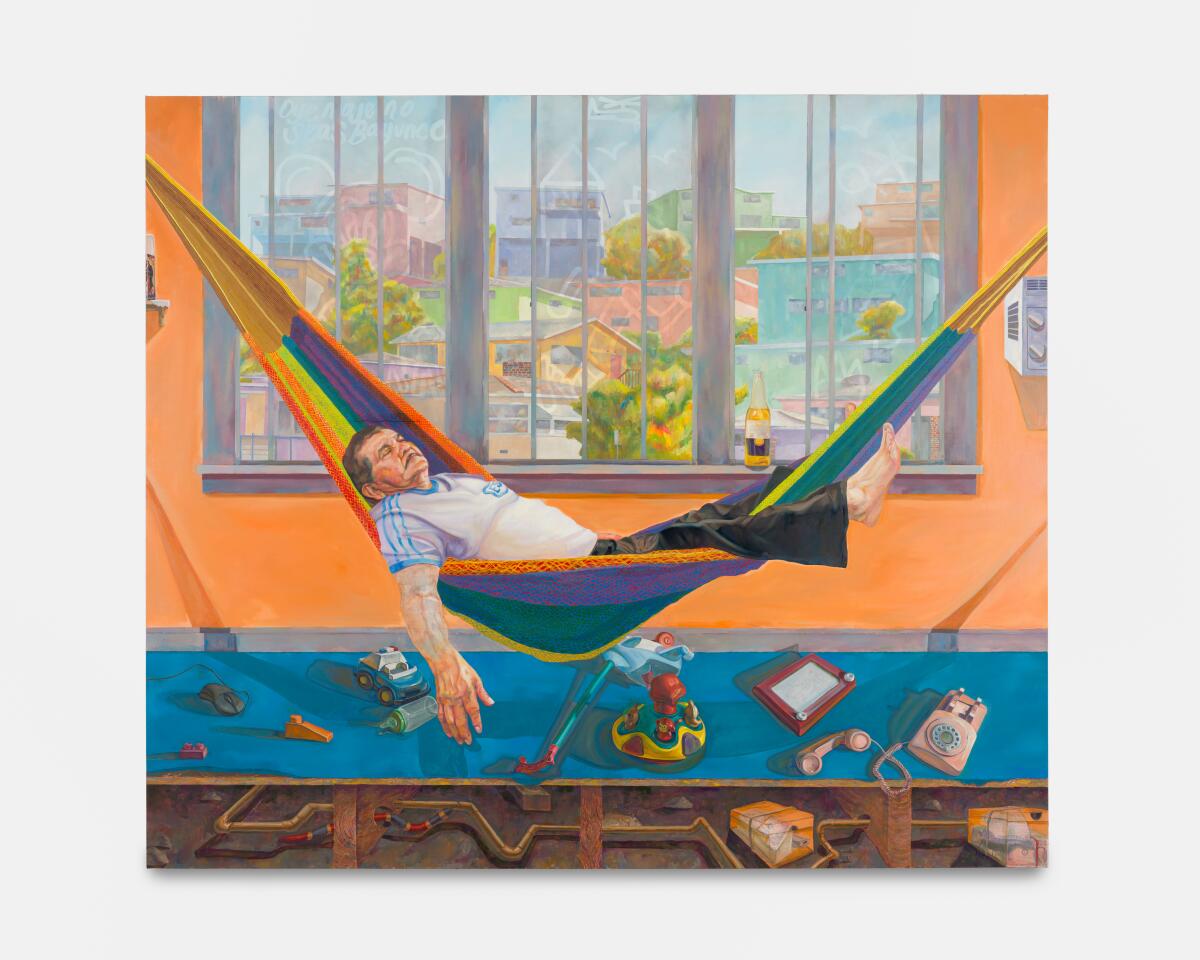The biggest entertainment stories
Get our big stories about Hollywood, film, television, music, arts, culture and more right in your inbox as soon as they publish.
You may occasionally receive promotional content from the Los Angeles Times.

In her text “The Carrier Bag Theory of Fiction” from the late 1980s, Ursula K. Le Guin writes about the importance of the “container” as one of “the earliest cultural inventions” in the early history of humankind. She goes on to discuss the novel as a container, tying in her approach to sci-fi writing. “That is why I like novels: instead of heroes they have people in them,” she writes.
When the science fiction author published her missive on containers, artist Elmer Guevara hadn’t been born yet. But decades later, the South Los Angeles-born and -raised artist would come across her writing, weaving it into his multilayered paintings of childhood, family and the city. Containers, both literal and not, stand in for family history and relationships in Guevara’s exhibition “House Money,” currently on view at the Charlie James Gallery. The exhibition features paintings, mixed-media works and drawings that depict Guevara and his family against backdrops of his home’s interior and exterior scenery.
Guevara captures ordinary moments in his life that are loaded with meaning, referencing his upbringing and his family’s personal history. Guevara’s parents left El Salvador in the 1980s, starting a new life in Los Angeles. “House Money” tracks his journey as a kid growing up in South LA in the ’90s, and as an adult confronting generational trauma and complicated family dynamics.
You can find many literal containers in the compositions, often used to store valuables. One piece, titled “Young Grasshopper,” features a young Guevara listening to a Walkman as a blimp floats above him in the distance. One hand carries a basketball, while the other cradles a box with prized possessions: money, a Game Boy and Spider-Man playing cards.
Growing up, Guevara remembers having neighbors who would often draw characters like “Dragon Ball Z” and “Beavis and Butt-Head.” As a teen attending Manual Arts High School, he explored L.A. by skateboard and bus; he remembers going to the beach the first time on the 33, getting off at Venice Beach. He often went on bike rides with friends, as they scouted spots for graffiti.
At East Los Angeles College, Guevara took a range of classes for two years before a counselor pointed out that he had enough credits to major in art. “By then I was like, “OK, cool, this is what I like to do,’” said Guevara. “And it requires a lot of hard work, but I was just like, ‘I’m willing to work it and just see how far it goes.’”
After getting his BFA from Cal State Long Beach Guevara took a year and a half off. He later moved to New York to pursue his MFA from Hunter College in 2019. The move from Los Angeles to New York was “a huge culture shock,” especially since he arrived during the winter.
At the time, Guevara was creating pieces that felt familiar to Angelenos but less so to the students in his cohort, who came from all over the world. He often referenced the helicopters that consistently fly over South L.A., a sight that New Yorkers aren’t as familiar with; some of his portraits included bus stop signs for local lines that Angelenos might recognize but others might gloss over. His color palette also seemed “very saturated” in contrast to the East Coast’s colors, a nod to his studies of work by artists in the Bay Area Figurative Movement.
His 2021 solo show at Residency gallery, “Mi Orgullo,” features works he made while away from home for the first time, many of them featuring his mom. “House Money” centers largely around himself, his dad and his brother; Guevara uses motifs such as a subtle line in “Young Grasshopper” that includes the year 1995, a nod to growth charts in homes tracking children’s heights over the years.

“House Money” also captures a distinct tension between the “violence in the ’90s and early 2000s era” and the “very joyful times” he experienced in his apartment complex, where cousins often lived, and the surrounding area.
“I didn’t know anything outside of South Central for quite some time until I was older, to realize that the Westside of L.A. was different or Beverly Hills was different than where I was from,” said Guevara. “So it took me to get out of my neighborhood to realize that there was any difference, really.”
Many works in the show feature photographs transposed onto the skin of the figures. Using gel transfers, Guevara places childhood photos and images of El Salvador’s civil war on the figures’ skin, in a nod to trauma that’s passed down from generation to generation, even when it’s not acknowledged out loud. Guevara calls the gel transfers a “ghostly material.”
“I love the challenge of trying to depict something that’s psychological like that — that’s not seen,” said Guevara. “I’m giving people access. Like, ‘Oh, look, these are the memories that I had in my body. You can see them if you look closely and investigate.’”
Artist Eduardo Gómez also attended Cal State Long Beach and identifies with Guevara’s subject matter and approach, especially as someone who also grew up in Southern California in a Latinx household. They met in 2021, at Gómez’s Eastern Projects solo show “A Dodger a Day.” Guevara was later a part of the inaugural group show at Altura, an artist-run space that Gómez co-created in Lincoln Heights; Gómez says these are the largest pieces he’s seen by the artist.
Both the gel transfers and the subtle motifs in the background of each composition are “moving your eye,” said Gómez, asking you to slow down and take it all in.
“They almost have this washed-out look to them,” Gómez continued. “They’re very faint and subtle. So you really have to pay attention and look hard to see these images and get the references. And I like how he does that, because he’s really making you look hard as opposed to just putting it in your face.”
An energizing summer show explores facades and faces. Plus: an exhibition on marginal states and Valkyries at the Bowl, in our weekly arts newsletter.
Ever Velasquez, gallery manager at Charlie James Gallery, first saw Guevara’s work about six years ago and instantly felt drawn to it. She describes Guevara as “a meticulous notetaker” who “wants to be precise about all composition.” In “House Money,” Velasquez said Guevara’s use of texture and colors, along with the artist’s willingness to dig deep into family history, are significant parts of the show.
“When it comes to male artists in Los Angeles specifically, they’re all doing works about their neighborhood but not necessarily intimate images of the people in their family,” said Velasquez. “He, in particular, is going deep with his family, showing you who they are and their living environment.”
This past March, Guevara spent time at Madrid’s Prado Museum, seeing works by Old Masters like Diego Velázquez that inspired him to create works on a larger scale than his previous pieces. Works like “Security Is Under the Mattress” echo the use of dramatic poses in classical paintings. In it, Guevara’s father sleeps peacefully, his body draped over a colorful hammock, one arm extending toward the floor. He’s framed by a large window that shows the neighborhood in the background; the panes display drawings that look like they were made by someone tracing their finger across dust or condensation.

Lately, Guevara has been reading memoirs including Javier Zamora’s “Solito,” a heartbreaking tale about the author’s migrant journey as a little boy coming to the U.S. from El Salvador on his own. Mike Davis’ often-cited “City of Quartz” and the documentary “LA 92” also are sources he returns to when making new work. He says his parents continue to support his work.
“I have this opportunity to make this stuff because of their journey here,” said Guevara. “Or, them giving me the opportunity, basically winning the opportunity for me so I can have a future. So for me, it’s an homage to paint them. I keep it simple, but I do paint the people that I really care about and I love and I cherish.”
‘House Money’
Where: Charlie James Gallery, 961 Chung King Road, Chinatown
When: 11 a.m.-5 p.m. Tuesdays through Saturdays and by appointment. Closes Sept. 16.
Info: (213) 687-0844, cjamesgallery.com
The biggest entertainment stories
Get our big stories about Hollywood, film, television, music, arts, culture and more right in your inbox as soon as they publish.
You may occasionally receive promotional content from the Los Angeles Times.